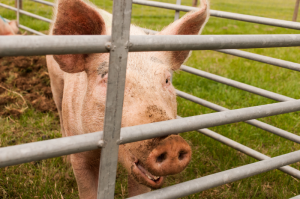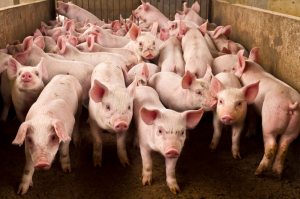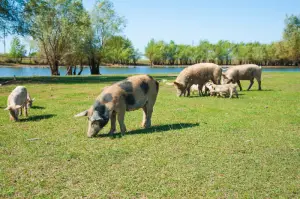How Many Pigs Should You Have Per Acre?
Raising pigs on pasture has a number of benefits for pigs, farmers, and consumers. If you’d like to try your hand at raising pigs on pasture, you will need to know how many pigs your land can support.
How many pigs can you keep on an acre of land? How many pigs you can sustainably run on an acre of land will depend on the quality of the pasture and the life stage of the animal. Generally, an acre of land should be able to support 10-15 growing pigs and up to 25-30 weanlings. Unlike most livestock, you must supplement a pastured pig’s diet unless he is on wooded or forested land.
Pigs are big business around the world, which means there has been ample research done into feeding pigs efficiently. Keep reading for a breakdown of how many pigs you can expect to keep on an acre of land and how much space a pig needs if kept in confinement.
How Many Pigs Can You Pasture-Raise On One Acre? 
In the agriculture and livestock scene, you may hear the term “stocking rate.” The stocking rate is the number of animals that one can sustainably keep on a specified amount of land. This stocking rate can vary significantly depending on a number of factors, including:
- Climate – a climate that sees more rain will see higher yields of crops or grass
- Pasture – pasture growth rates will depend on the plant that is grown
- Life stage – a gestating or lactating sow will require more feed than a gilt, just as a mature boar will require more feed than a weanling.
Understanding that there are a number of factors that will affect your particular stocking rate, below are the average numbers of animals you can expect to keep on an acre of land (assuming you are also feeding supplemental grain).
Life Stage # of Pigs per Acre
| Weanlings and pigs up to 100 pounds | 15-30 |
| Pigs 100 pounds and higher | 10-20 |
| Pregnant sows | 8-12 |
| Sows with litters | 6-8 |
This should be seen as a general range and not an exact science. A desert acre that is not irrigated will be offering much higher amounts of supplemental feed than an acre of land in a climate that receives rainfall year-round.
How Many Pigs Can You Keep In Confinement? 
Though “pastured meat” is becoming increasingly popular among consumers, the vast majority of livestock raised for market are raised in confinement settings.
As large as pigs are, you may be surprised at how little space is actually required. It is recommended that pigs living on dry lots or in “pig pens” have a minimum of 8-10 square feet each. While these are generally accepted minimums, I recommend providing each of your pigs with as much space as possible.
As an FFA kid, I raised pigs through my school years in a barn that was attached to our high school campus. The pigs were kept in stalls within a barn that was built on cement.
There were many pigs raised by students until market weight, but even in these cramped conditions, each pig still had more than 8 square feet of space to move around in, and the students would often “exercise” their individual pigs in the grassy enclosure behind the barn.
These pigs were well-cared for, but the sanitation requirements alone could have become overwhelming had there not been a handful of students assigned to clean the barn every day.
It is important to keep these considerations in mind when deciding how many pigs to keep in a confined (or pastured) space. Though you may have a barn large enough to accommodate 40 pigs, do you have the time and resources to care for them?
I recommend starting with a smaller number of pigs in the beginning. It’s easy enough to add more pigs to a herd as time goes on, whether through breeding or through purchasing, but it can be more challenging to offload a number of pigs if you decide you’ve taken on more than you can handle.
Can Pigs Survive On Pasture Alone?
Most livestock needs nothing more than high-quality pasture to thrive. Cattle, sheep, and even llamas can meet all of their needs if provided with ample, nutritious fields. Pigs have different dietary requirements; however – they are omnivores, whereas most other livestock is strictly herbivorous.
A pig living in the wild will consume about 90% of its diet through plant matter, but that last 10% will require increased protein. While 10% is a relatively small percentage of one’s diet, that small piece of the puzzle makes a big difference in determining whether an animal will thrive and grow or just survive.
This means that even if you have a large plot of green grass, you will likely need to supplement your pig’s diet with a complete feed. If you have a heavily wooded acre of land, your pigs may be able to meet all of their dietary requirements from the land.
The best kind of pasture for pigs will be high in protein, like alfalfa and other legumes. Rape is neither legume nor grass, but is also highly nutritious for pigs. Farmers raising pigs on a high-quality legume pasture can see their grain consumption cut in half, providing significant cost savings to the operation.
Depending on the region you are in, you may see higher yields growing grass over legumes. If this is the case, you can grow a half-legume, half-grass pasture – this 50/50 combination has proven to work just as well as an entirely legume pasture in most scenarios.
What do pigs eat in the wild?
Most “wild” pigs in the United States are actually feral pigs that were once domesticated, even if they are several generations removed. Feral pigs do well in wooded and forested areas, eating all kinds of plant matter, including flowers, roots, fruits, leaves, nuts, and acorns.
They will also eat grubs, bird eggs, small animals such as frogs and mice, and carrion. Pigs are opportunistic eaters who “root” instead of graze, getting a bulk of their diet from under the earth.
Benefits Of Raising Pigs On Pasture
Despite the fact that most pigs cannot meet all of their nutrition requirements on pasture alone, there are still several benefits to raising pigs on land, including:
- Quality of life – if a pig could speak, he will likely tell you that he prefers rooting and exploring the land over living in a cement pen or a dry lot. Most animals would say the same. Raising a pig on pasture or forage allows you to meet your pig’s mental and emotional needs for stimulation and activity on top of his physical needs.
- Exercise – like all animals, pigs need the ability to move around and exercise, and raising them on land is an excellent way to achieve this.
- Improved sanitation – if you’ve spent much time with pigs living in tighter conditions, you likely remember the smell. Pig farms have been proven to be the “smellier” of livestock farms due to the types of bacteria and different chemicals found in the pig’s feces. Pigs poop a lot, and spreading that poop over an acre of land is usually easier to manage and easier to live with than that same amount of poop in a confined space.
- Improved parasite control – aside from the bacteria living in a pig’s feces, there are also a number of parasites that enjoy residence in your animal’s waste. If your pig lives in small accommodations, the poop will accumulate much more quickly, and those parasites will take advantage of this environment.
- Additional nutrients for breeding sows – it has been shown that breeding sows do particularly well when living on pasture or forage, likely due to the additional nutrients found in this varied diet. If you breed your sows, it may be especially beneficial to raise them in this environment.
- A natural way of living – of course, it is always ideal to raise an animal in an environment that most closely mimics its natural living conditions. This is not only beneficial to the animal’s mental health but also allows the pig to live in an environment that his body has become adapted to over hundreds of years.
Keeping Pigs On One Acre Of Land
As you can see, there is more to consider when deciding how many pigs to keep on an acre of land than numbers alone. There are many factors that go into those numbers, including the life stage of the animals, the type of forage and pasture available, and whether or not the land is irrigated (either naturally or not).
Nevertheless, if you have an acre of land that is properly fenced and available to your pigs, allowing them to forage is usually preferable to keeping them on a dry lot. Not only will your pigs be happier, but your wallet might thank you too. You can learn more about owning and caring for pigs in my articles below or find my latest content here.

